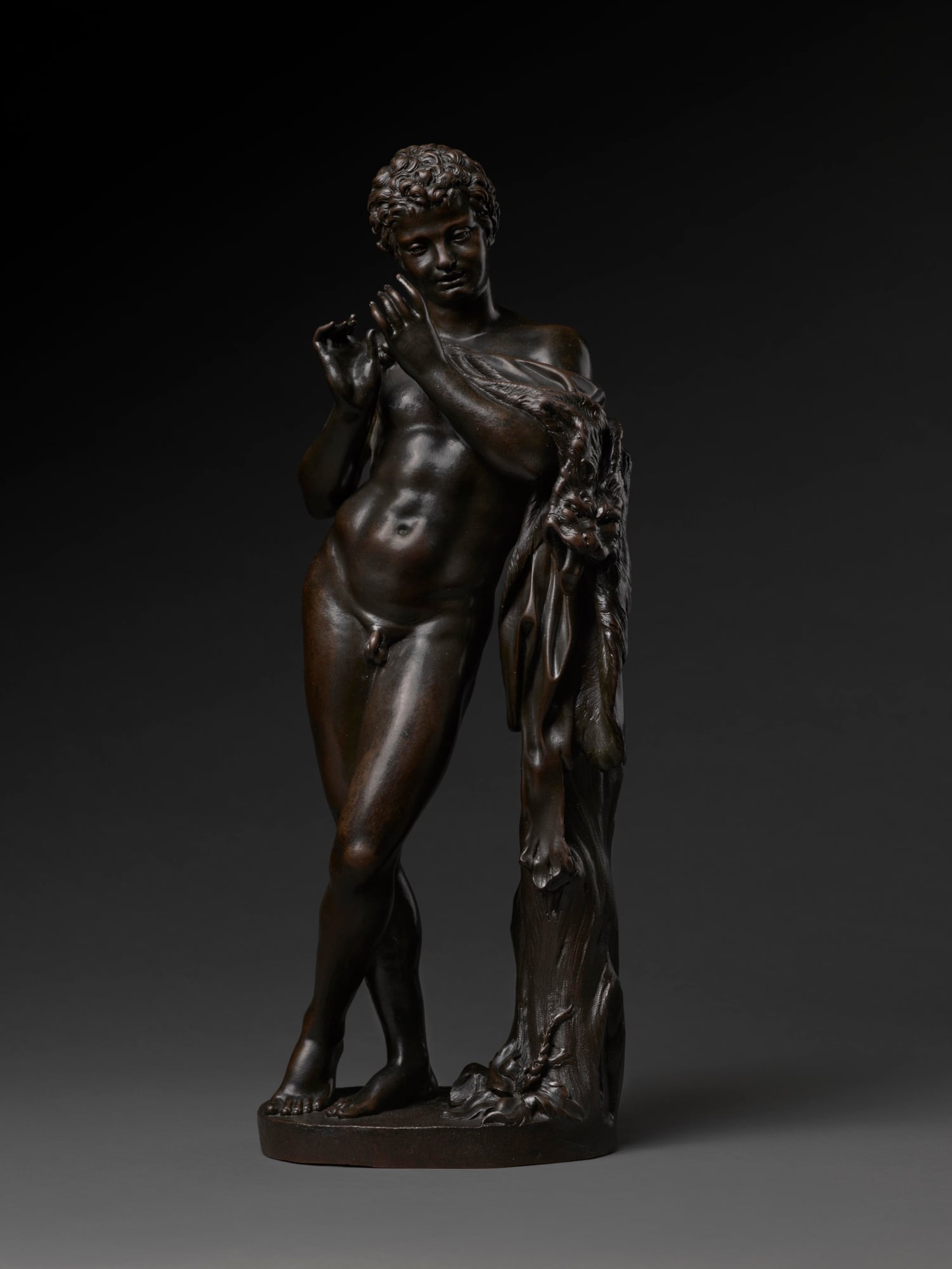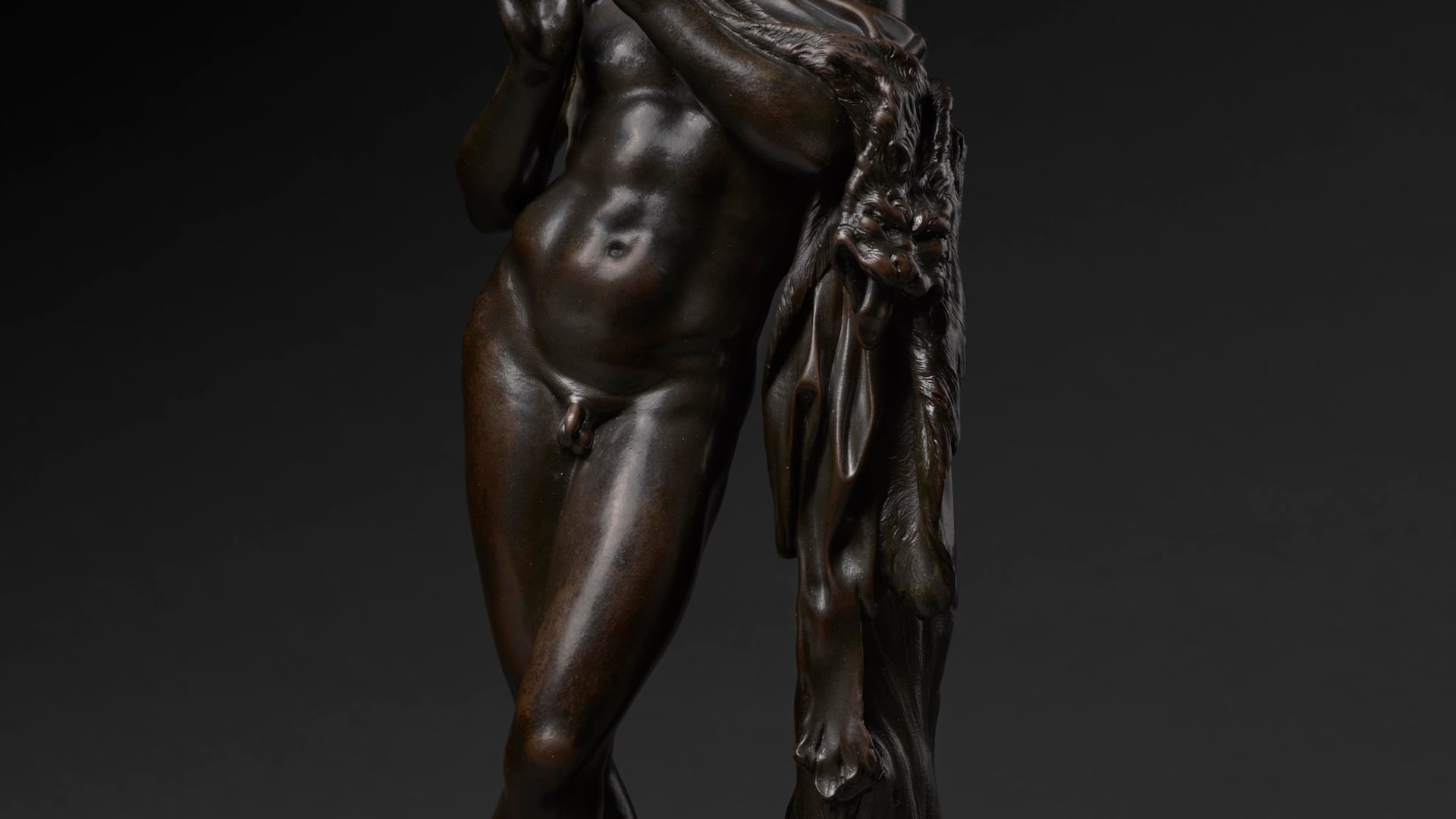

One of the 13 bronzes purchased by Thomas, 1st Earl of Macclesfield, 15 July 1723 for a total of £300.
Thence by descent at Shirburn Castle,
Important European Furniture, Sculpture and Carpets Including The Macclesfield Sculpture; Christie's London, 1 December 2005, lot 62.
Private Collection to 2024,
Acquired from the above.
Thence by descent at Shirburn Castle,
Important European Furniture, Sculpture and Carpets Including The Macclesfield Sculpture; Christie's London, 1 December 2005, lot 62.
Private Collection to 2024,
Acquired from the above.
T. P. Connor, 'The fruits of a Grand Tour - Edward Wright and Lord Parker in Italy, 1720-22', in Apollo, July 1998, pp. 23-30.
F. Perrier, Segmenta nobilium signorum et statuarum que temporis denteminvidium evase, 1638, no. 48.
F. Haskell and N. Penny, Taste and the Antique - The Lure of Classical Sculpture 1500-1900, New Haven and London, 1981, no. 39.
F. Perrier, Segmenta nobilium signorum et statuarum que temporis denteminvidium evase, 1638, no. 48.
F. Haskell and N. Penny, Taste and the Antique - The Lure of Classical Sculpture 1500-1900, New Haven and London, 1981, no. 39.
The ancient marble Faun with Pipes, upon which the present exceptional bronze is based, was recorded in the Villa Borghese, Rome, by 1638. It remained there until 1807 when it was purchased, along with much of the Borghese collection, by Napoleon Bonaparte - brother-in-law to Prince Camillo Borghese. In 1815 it was installed in the Louvre, where it now resides.
Its popularity was evidently significant since it featured in Francois Perrier's 1638 anthology
of the most admired statues in Rome. It was copied extensively in the 17th and 18th centuries being reproduced in engravings, plaster casts, Wedgwood and bronze. The bronze and plaster casts acquired by Thomas Parker, 1st Earl of Macclesfield, on his Grand Tour form one of the most remarkable collections of after the antique sculpture assembled in the first half of the 18th century by an English aristocratic family. The present work is one of the 13 exceptional bronzes commissioned by Lord Macclesfield in 1723; most likely from the workshop of Pietro Cipriani, who was active in Rome during this time. Lord Macclesfield’s son, George Parker, himself travelled to Italy the following year on his Grand Tour and notably commissioned two life-size bronze casts of the Venus de’ Medici and Dancing Faun for his father (Sold to the Getty Museum by the Katz Gallery). These bronzes were signed and dated by Pietro Cipriani. It therefore seems likely George visited his workshop following the advice of his father who commissioned the present work the year prior.
The facture and level of hand-finshing between both sets of examples are remarkably similar and point to common authorship.The colour of the metal and method of manufacture indicate the group was cast at the same foundry as the Cipriani Venus and Dancing Faun. It is likely that Lord Macclesfield engaged an agent specifically for the purposes of replicating examples of sculpture which he had seen during his time in Italy. The man to whom Lord Macclesfield made the payment is mentioned in a document dated 15th July 1723 and now housed in the National Archives. In it mentions John Smibert, a Scottish artist who is known to have been in Rome at the same time as Lord Macclesfield and who likely arranged and oversaw the casting and delivery of the 13 bronzes from Rome to England where he was able to take measurements and casts of various sculptures.
Its popularity was evidently significant since it featured in Francois Perrier's 1638 anthology
of the most admired statues in Rome. It was copied extensively in the 17th and 18th centuries being reproduced in engravings, plaster casts, Wedgwood and bronze. The bronze and plaster casts acquired by Thomas Parker, 1st Earl of Macclesfield, on his Grand Tour form one of the most remarkable collections of after the antique sculpture assembled in the first half of the 18th century by an English aristocratic family. The present work is one of the 13 exceptional bronzes commissioned by Lord Macclesfield in 1723; most likely from the workshop of Pietro Cipriani, who was active in Rome during this time. Lord Macclesfield’s son, George Parker, himself travelled to Italy the following year on his Grand Tour and notably commissioned two life-size bronze casts of the Venus de’ Medici and Dancing Faun for his father (Sold to the Getty Museum by the Katz Gallery). These bronzes were signed and dated by Pietro Cipriani. It therefore seems likely George visited his workshop following the advice of his father who commissioned the present work the year prior.
The facture and level of hand-finshing between both sets of examples are remarkably similar and point to common authorship.The colour of the metal and method of manufacture indicate the group was cast at the same foundry as the Cipriani Venus and Dancing Faun. It is likely that Lord Macclesfield engaged an agent specifically for the purposes of replicating examples of sculpture which he had seen during his time in Italy. The man to whom Lord Macclesfield made the payment is mentioned in a document dated 15th July 1723 and now housed in the National Archives. In it mentions John Smibert, a Scottish artist who is known to have been in Rome at the same time as Lord Macclesfield and who likely arranged and oversaw the casting and delivery of the 13 bronzes from Rome to England where he was able to take measurements and casts of various sculptures.